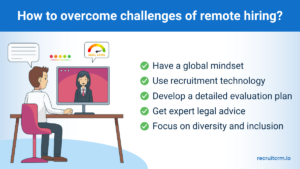In recent years, the corporate world has witnessed a significant shift towards remote recruiting, a trend propelled by technological advancements and evolving work cultures.
A survey by Forbes found that more than 16% of businesses worldwide operate entirely remotely.
This transition, although beneficial, presents a unique set of challenges, especially for recruiters and staffing agencies exploring the international waters.
So let’s examine the benefits and challenges of international remote recruiting, along with effective strategies to navigate them.
Top benefits of remote-first hiring

1. Wider talent pool
Remote-first hiring gives you access to a larger and more diversified candidate pool.
Without geographical boundaries, you can get qualified professionals from around the world, including those with skills and unique perspectives that may not be readily available in your local market.
This diversity of expertise can help stimulate innovation, creativity, and problem-solving within the company, strengthening its competitive edge.
2. Cost reduction
Virtual recruiting minimizes the need for actual office space, utilities, and overhead costs.
Firms can also target talent from regions with lower living costs, resulting in more competitive wage packages.
These cost savings not only help the company’s bottom line but also make it more appealing to prospective employees since they can get a better pay while residing in less expensive locations.
3. Improved employee satisfaction
Individuals get the flexibility to choose when and where they work, aligning with their diverse lifestyles and preferences.
You can compare this to the advantages of becoming an Uber driver, where one has the freedom to choose their work hours.
It contributes to improved work-life balance, reduced commute-related stress, and more control over one’s work environment.
Don’t forget that satisfied employees are typically more engaged, productive, and likely to repay the chance to work flexibly by staying with the company in the long run.
This helps reduce turnover rates and other recruitment expenses.
4. Long-term flexibility
Remote hiring propels businesses into a future where geographical boundaries are non-existent, fostering agility and innovation.
It allows companies to seamlessly adapt to market trends by tapping into a global talent pool, facilitating strategic expansion without the constraints of physical locations.
5 major challenges associated with international remote hiring

1. Time zone differences
Due to time zone differences, scheduling interviews with remote applicants from some countries could be difficult.
Imagine being in New York and having to coordinate with a team member in Tokyo; the stark difference in working hours can lead to delays and miscommunications.
And it’s not just about scheduling interviews. It extends to regular team meetings, project collaborations, and deadline settings.
2. Talent evaluation and assessment
Another hurdle in the path of international remote hiring is the evaluation and assessment of talent.
Recruiters often find themselves navigating through complexities like foreign credentials and certifications.
The challenge amplifies when there is a discrepancy in the educational standards and evaluation criteria across different countries.
That’s why it becomes a meticulous task to assess the authenticity of the candidates’ qualifications and to equate them with the standards of the hiring company’s country.
3. Language and cultural differences
Language barriers and cultural differences stand as prominent challenges in the remote recruiting process.
Even when both parties communicate in a common language, the nuances, accents, and colloquialisms can sometimes lead to misunderstandings.
Moreover, the recruitment process often unveils varying cultural norms and expectations. For instance, the perception of professionalism, punctuality, and work ethics can vary notably across cultures.
4. Contractual legalities
Every organization must create legal contracts for its employees, including remote workers.
Companies need to be well-versed with the labor laws and regulations of different countries to ensure compliance.
This involves understanding the nuances of employee classification, wage regulations, and work conditions prevalent in various regions.
Also, the documentation extends to safeguarding the company’s interests and adhering to the international standards of employee rights and benefits.
5. Data privacy and security concerns
Handling sensitive candidate data and adhering to data privacy requirements, particularly when dealing with overseas candidates, requires a robust security framework.
This is due to the risks involved, such as data breaches and identity theft, which can put candidates at risk and result in a legal and PR nightmare.
That is why, companies need to ensure stringent data security measures, including encryption and access controls, to safeguard candidate information.
Not to forget, but adherence to international data privacy regulations, such as the General Data Protection Regulation (GDPR), is imperative to maintain trust and avoid any complications.
5 simple ways to navigate the challenges of international remote hiring

1. Develop a global mindset
Developing an understanding and respect for different cultures, languages, and work ethics is indeed a necessity.
It’s about appreciating the rich diversity that candidates from various backgrounds bring to your team.
Consider investing in training programs that enhance intercultural competence, paving the way for an inclusive and harmonious work environment.
2. Leverage technology to your advantage
Recruitment technology is your ally in tackling the challenges of time zone differences and streamlining the entire hiring process.
Advanced scheduling tools can be a lifesaver, adjusting automatically to different time zones and facilitating seamless coordination of interviews and meetings.
You can also use tools like applicant tracking systems (ATS), AI recruiting software, or recruitment CRMs that can significantly organize your operational tasks.
Don’t forget to check out Recruit CRM if you’re looking for an easy-to-use ATS + CRM.
3. Develop a comprehensive evaluation process
When it comes to assessing the qualifications and credentials of candidates from different countries, a well-rounded evaluation process is key.
Collaborating with international educational bodies and utilizing AI-powered tools can help in analyzing and equating foreign qualifications with your country’s standards.
You can also implement a robust background verification process to authenticate the candidates’ claims, ensuring a transparent and trustworthy hiring process.
4. Seek expert legal guidance
Don’t let the intricate web of international labor laws slow you down.
Collaborating with legal professionals who specialize in global employment regulations can assist you in crafting compliant contracts and policies.
This proactive approach can prevent potential legal hurdles, ensuring a smooth and lawful hiring process.
5. Foster a culture of diversity and inclusion
Lastly, building a diverse and inclusive team goes beyond ordinary hiring practices.
It’s about nurturing a culture that celebrates diversity and promotes inclusivity.
Consider initiating diversity training programs to educate employees about the value of diverse perspectives, creating a team that thrives on mutual respect and understanding.
Frequently asked questions
1. What are some best practices for onboarding remote employees?
Best practices for onboarding remote employees include:
- Setting clear expectations: Clearly outline job roles, responsibilities, and goals to provide a roadmap for new hires.
- Comprehensive training programs: Develop detailed training modules to equip remote employees with the necessary skills and knowledge.
- Mentor or buddy assignment: Assign a seasoned team member to guide and assist the new hire during their initial days.
- Virtual meet-and-greets: Organize virtual sessions where new employees can meet and interact with the team, fostering a sense of belonging and community.
- Resource accessibility: Ensure that new hires have easy access to all the necessary resources and tools from day one.
- Feedback and adjustment: Encourage new hires to provide feedback on the onboarding process and be ready to make adjustments based on their input to continually improve the process.
2. What tools do I need for remote hiring?
For a successful remote hiring process, you might consider utilizing a combination of the following tools:
- Applicant tracking system: To organize and track candidate information.
- Video conferencing software: For conducting remote interviews.
- Project management tools: To manage tasks and workflows efficiently.
- CRM platforms: To streamline client and candidate interactions.
- Background checking software: For verifying candidate credentials and background.
- Legal consultancy services: To assist in crafting compliant contracts and policies.




